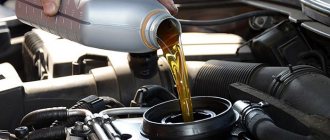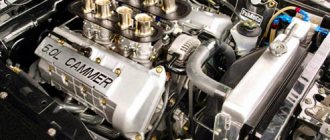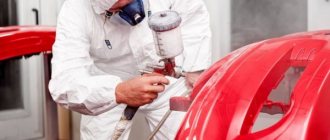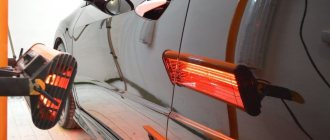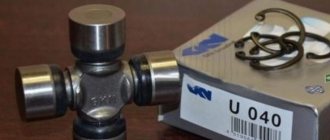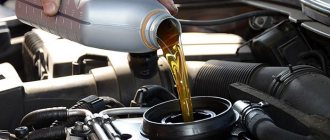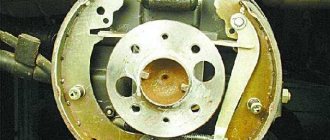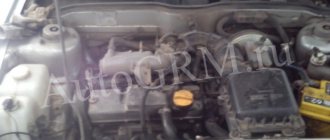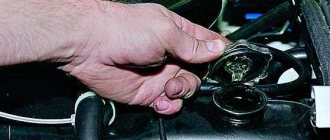How long does it take to break in new rings?
Well, the time has come to replace the rings, as well as the valves, mileage over 200 thousand, oil from max to min. fell quickly, over 1000 km (then it almost stood still, but there is already a little gasoline in the oil, etc., so it seems that the level does not decrease, and there is gasoline + oil + carbon deposits instead of oil), when warmed up, unevenness was felt work (slight floating vibration, as if the speed is floating). The compression also had a range: 1 - 12, 2 - 11.2, 3 - 12, 4 - 10.3
(in reality, most likely even lower, because the oil ate well - it was most likely oil compression in some cylinders, and these values are overestimated).
It was decided to change the rings and rebuild the cylinder head - valves + guides + caps. After disassembly, it was discovered that there were 2 pistons repaired, 82.8 mm (the square was knocked out), the cylinders were free of scuffing and everything was very tight, it didn’t move anywhere, the rings weren’t visible if you looked from above. All pistons + combustion chambers + ring grooves on the piston were covered in a heavy layer of carbon deposits. washed with Sanita anti-grease gel (smear it on for 20 minutes and wash it off, and so on several times), the grooves for the rings were cleaned down to metal with fragments of old rings. All the rings were on the verge of falling, heavily worn (by eye the thickness of the new and old ones was significantly different). All new rings had to be ground down with a needle file, because... the gap was less than 0.25mm at the joint when installed in the cylinder. The piston with new rings did not fit into the 3rd cylinder - a belt of rust formed on top where the rings do not go, which was carefully sanded and lubricated with oil, and only after that it was possible to drive the 3rd piston.
After reassembling the cylinder head (replacing valves, guides, cutting in seats, lapping (crappy, as it turned out),
trimming of exhaust valves, because
the saddles are not the first freshness (the old ones were also trimmed), after assembly the compression showed only: without oil: 1 - 7 2 - 8.7 3 - 5.9 4 - 7.5 with oil: 1 - 8 2 - 9, 8 3 — 6.4 4 — 9.3
From which the conclusion was drawn that the grinding was bad, because
compression with oil did not rise much anywhere, and the leaking valves do not allow it to rise, which was confirmed after disassembling and pouring kerosene into the channels, everything was leaking
)).
Be sure to check the valves with kerosene, or for even scratches on the seat chamfer around the entire circle,
because
the valve is completely rubbing in, but the seat may not be rubbing in yet and it will be a bummer
.
If the valves get a little wet (do not leak), especially if this does not happen immediately, then this is normal lapping, otherwise some comrades think that the valves should be left with kerosene for days, but the valve is not a pipeline
, and the compression stroke there lasts tenths/hundredths split seconds, so
don’t rub until you’re fanatical, just sag the saddles.
.
After assembly with standard ground-in valves, the compression became:
:
1 - 9.5 2 - 10.5 3 - 7.7 - with oil 10.6 (unpolished rings where the belt was slightly sanded) 4 - 9.7
After 10 km!:
Started the car, drove only >10 km Price tag: 6,000 ₽ Mileage: 207000 km
Good afternoon. The engine began to actively take oil. I decided to change the rings. After opening it, it turned out that the decision was correct - the rings were indeed a pipe. But after replacing the rings, oil consumption increased even more. I've already driven 600 km, and oil is flying into the pipe. They explained to me that I need to wait 1500-2000 km until the rings wear in, and during this time fill in 15W40 mineral oil.
I would like to hear the public's opinion on this issue. Thank you.
Replacing piston rings is a procedure that will have to be encountered if the driver has been using the car for a long time. On average, the service life of the rings is 80-120 thousand kilometers, depending on the driving style, as well as the quality of the rings themselves and the assembly of the car engine.
After replacing the piston rings, many drivers forget about the need to break in the car. This is an extremely important procedure that should not be neglected if you want to ensure that engine repair and piston ring replacement are not in vain. In this article we will look at how to break in a car engine after replacing the piston rings.
#1 Pepper
- Group: FB Veterans
- Posts: 293
- Registration: 22 September 07
In my case, replacing the rings (compression + valve stem seals) and valve stem seals. It seems like it wouldn’t hurt to give the little guy a run-in? The question is: how many kilometers can you drive in the “vomit-fry-fry-vomit-fry” mode?
- Up of the page up there ^
#2 Lonely Wolf
- Group: Members
- Posts: 49
- Registration: 28 September 09
- Up of the page up there ^
#3 Shell-68
- Group: FB Veterans
- Posts: 4,864
- Registration: 08 April 08
- Up of the page up there ^
#4 Lonely Wolf
- Group: Members
- Posts: 49
- Registration: 28 September 09
- Up of the page up there ^
#5 joni
- Group: FB Veterans
- Posts: 2,120
- Registration: 20 July 07
- Up of the page up there ^
#6 ODAN
- Group: Members
- Posts: 191
- Registration: 28 January 10
Lonely Wolf (22.3.2010, 20:06) wrote:
- Up of the page up there ^
#7 Lonely Wolf
- Group: Members
- Posts: 49
- Registration: 28 September 09
ODAN (22.3.2010, 23:08) wrote:
- Up of the page up there ^
#8 Pepper
- Group: FB Veterans
- Posts: 293
- Registration: 22 September 07
funny..About the hoods.. Perhaps everything there from the factory comes with such tolerances that you really need to fuck it up if something falls off right away.. This option doesn’t work for me.. The replacement process is too gimmicky (rings take a long time to get to Russia)
I'm still waiting for adequate advice. Vomiting, I don’t know how much, and then frying it is not a break-in and I’m fucked, sorry.. In general, there are probably no questions with the break-in mode. Question about mileage...
Types of engine break-in
The further operation of the vehicle depends on correctly performed running-in. Depending on the situation, running-in can be of several types:
- After partial engine overhaul;
- After major renovation;
- After replacing components.
After a major overhaul of the engine, running-in is carried out in order to grind in all engine components. It is better to carry out such running-in at a service center where special equipment is available. As for other cases, the running-in must be performed directly on the road, that is, while the car is moving.
How to perform break-in after replacing piston rings?
Before running in, the car must be prepared. To do this, perform the following steps:
- Infects a car battery;
- Before leaving on the road, start the engine and warm it up to 80 degrees;
- After warming up, the engine is turned off and cooled to 40 degrees;
- Next, warm up again to 80 degrees and repeat the procedure at least 8 times;
- After preparation, inspect the machine and unit for faults;
- They drive onto a highway with little traffic and no bumps.
Basically, the rules for engine break-in are described in the technical operation book. Before you break in the engine yourself, be sure to read the manufacturer's recommendations.
How to break in the engine after replacing the piston rings will be discussed in detail using the Priora as an example in this video:
How to break in after replacing piston rings
Before you begin the break-in procedure, you need to prepare the car. A few steps to follow:
Charge the battery;- Before heading out on the road for the first time, first start the engine and wait until it warms up to 80 degrees Celsius. After this, you need to turn it off and wait until the engine cools down to 40 degrees Celsius. Then the engine warms up again to 80 degrees. You need to perform 8-10 such cycles. This is necessary so that preliminary “grinding in” of the parts occurs, caused by their expansion as a result of heating;
- After completing the preliminary step, inspect the car and engine. You need to make sure that there are no leaks of antifreeze, oil or other liquids. If a problem is identified as a result of the inspection, it must be corrected;
- Choose the right section of road to drive. It is better that this is a route with a small number of cars and no elevation changes, that is, it is necessary to exclude entry to and from the slope. You also need to minimize the likelihood of getting stuck in a traffic jam.
Important: The book on technical operation of a specific car model may discuss the issue of engine break-in. Be sure to read and follow the manufacturer's recommendations.
Experts recommend running in the car engine after replacing the piston rings for 1,500 kilometers. The break-in process itself should take place, on average, at 2500 rpm; it is better to do it in third gear. This recommendation will allow you to optimize the process of “grinding in” the rings to the piston and cylinder.
It is better to cover the first 300 kilometers in one ride. A country track is ideal for grinding in. The next 1,200 kilometers must be covered in the same mode, but no matter how many trips, that is, operation can be carried out in a schedule that is comfortable and familiar to the driver.
Important: After traveling 1500 kilometers, it is necessary to replace the oil filter and oil.
( 180 votes, average: 4.54 out of 5)
What is engine hydraulic hammer
Liner defects in a car engine cylinder block
Related Posts
Changing the oil after engine overhaul
It should be understood that the obligatory result of grinding in parts (especially in the first hundreds of kilometers) in the engine is metal shavings. These chips enter the engine oil and accumulate in the oil filter. It is quite obvious that these chips need to be removed from the internal combustion engine.
This can be done by draining the lubricant and replacing the filter. This replacement needs to be done after 800-1000 km. By the way, you only need to fill it with suitable high-quality motor oil immediately after repairing the engine, before the first start, during the first replacement and further during operation.
Signs of piston ring wear
Blue or black smoke from the exhaust pipe indicates that wear has reached a critical stage. This indicates that excess oil entered the combustion chamber past the oil scraper ring and burned there along with the fuel. Black smoke coming out of the crankcase ventilation tube indicates that the compression rings, due to wear, allow gases to escape from the combustion chamber into its cavity.
Critical wear is accompanied by a decrease in compression (the ability to maintain pressure) in the engine cylinders. This means that some of the gases formed during the combustion of the fuel mixture, which was supposed to push the piston, broke into the crankcase without performing useful work. This is what will lead to a drop in pressure in the cylinder, therefore, the engine will lose some power. Increased oil consumption is observed.
Compression is checked with a special device - a compression meter. When the nominal pressure values are unknown (there are no operating instructions), it is first measured in a dry cylinder, then a little engine oil is poured through the spark plug hole, and the measurement is made again. If the compression increases, then the rings need to be replaced. Similar signs can be observed in the case of their “occurrence”.
“Sticking” occurs when carbon deposits formed in the piston grooves prevent the piston rings from springing, resulting in a decrease in the tightness of their contact with the cylinder surface.
This problem, if the case is not very advanced, can be corrected with the help of special fuel additives. For an engine with a carburetor system, you can try cleaning it with a carbon remover spray that is injected directly into the carburetor. If removing carbon deposits from the combustion chamber has no effect, then there is only one way out - replacing the piston rings and cleaning the grooves.
This is interesting: Broken timing belt and possible consequences - causes, symptoms, repair
Features of removal and installation
First rule. When performing work, it is imperative to maintain cleanliness. Before dismantling the power unit, you should go to the car wash and remove all remaining dried dirt and dust using a high-pressure washer. Using a special cleaning agent, the engine housing is washed. You cannot wash a hot engine, since a sudden temperature change has a negative effect on the engine. Be sure to disconnect the battery. As soon as the body is processed, you need to wait a while until the motor dries out. Using compressed air from the compressor, remove all drops of water, and also treat the wire connections.
Second rule. Keep track of how the parts were before disassembly. It is best to use a digital camera or a smartphone with a good camera. Use your camera to take step-by-step photographs of the parts being disassembled.
Disassembly
First you need to dismantle the power unit. It is noteworthy that in some scooter models - for example, Honda Dio before 1994, you can completely replace the piston without removing the entire engine. Disassembly order:
- Unscrew and remove all parts that interfere with dismantling - throttle cables, rear brake cables, fuel and oil supply hoses, electrical blocks, shock absorber, and so on.
- In most models, the engine is secured with just one bolt to the frame. Unscrew it and roll out the engine.
- Remove the muffler, air filter, cylinder and generator casing. Using a compressor and brush, completely remove any dust from the cylinder. If necessary, wash the cylinder again. The part must be perfectly clean.
- Unscrew the spark plug and unscrew the nuts/bolts that secure the cylinder head. Before performing work, be sure to wash all the places where the crankcase is connected to the cylinder. Even if the engine was washed anyway, there will always be sand and dirt under the fins. When removing the cylinder, residual dirt may penetrate inside the crank chamber.
- Unscrew the head and then proceed to dismantle the cylinder. In some cases, it happens that the cylinder is stuck and does not want to be removed easily. Here you need to pick it up using a pry bar. If you find that the cylinder gaskets are coming off in chunks and are stuck to a metal surface, you should carefully and carefully remove them. It is important to achieve maximum surface evenness. If there is no replacement gasket, you need to buy a new one or a paronite sheet and cut a new gasket out of it. It also happens that during the repair process the owner damaged the aluminum gasket located between the cylinder and the crankcase. You can do it yourself and make a new gasket using a cola can. But before that you need to completely remove all traces of paint.
- A clean cloth should be placed between the crankcase walls and the connecting rod to prevent foreign objects from getting into the crankcase. If this requirement is not met, the new cylinder-piston group will most likely fail in the future, and the crankshaft will also break.
- To squeeze out the pin, you must first remove the stopper from the piston pin. Always remember that the finger fits quite tightly, so you will have to make a lot of effort to remove it. While pushing out the pin, make sure there is no lateral load on the connecting rod. Otherwise, you will have to purchase a new one, since the old part in this condition is not subject to further use. The operation must be performed so that the piston rests against an object sideways. You can support it on the wall by laying a piece of wooden beam.
- Remove the piston and get rid of the cage bearing. The old gasket should also be removed.
After completing all the work to dismantle and restore the cylinder-piston group, it is necessary to perform the installation in the reverse order.
Step-by-step instructions for replacing rings and valve stem seals
The decarbonization process removes small deposits. In case of severe wear, a complete replacement of all piston rings and valve stem seals is required:
- The necessary parts are selected in accordance with the make of the machine. You should give preference to original spare parts so as not to bother again later.
- The spark plugs are unscrewed, the cover is removed, and then the entire cylinder head (cylinder head). The oil is drained and the oil pan is unscrewed. Next, the connecting rod caps are unscrewed and the pistons are pulled out.
- Use a puller or a screwdriver to remove the old rings. Using old pistons, the landing grooves are cleaned. It is done carefully with an unnecessary ring. Their installation should be carried out only after connecting the piston to the connecting rod.
- Of all the piston rings, the oil scraper rings are installed first. All operations must be done by hand. On box-shaped ones with a spiral spring, the expander lock rotates 180° relative to the ring lock. For composite ones, the spring is installed first, then the lower plate and the upper one. The plate locks rotate 180° relative to each other.
- After installing the remaining rings, it is necessary to evaluate the appearance of the cylinders. In case of severe wear, boring and honing are performed.
- Place the pistons in their places, screw on the connecting rod caps and the oil pan.
Valve seals also play an important role in retaining oil. They remove excess from the valves. The caps are replaced either with or without removing the cylinder head.
- In the first case, the crankshaft is turned with a wrench until the first pair of pistons is set to the top dead center (TDC) position. This is done to keep the valve from falling into the cylinder.
- The axles of the intake and exhaust rocker arms with hydraulic compensators are removed. In many models they can fall out - nylon clamps are useful for this.
- Using a special puller, you must simultaneously compress the valve springs and remove the crackers with tweezers. They are needed to compress the spring relative to the valve axis. An assistant will come in handy here.
- After removing the worn cap, install a new one in its place. It should be remembered that they are divided into inlet and outlet.
- The crackers are installed in reverse order. Next, you should rotate the crankshaft to the TDC position of the other pair of pistons. Everything is done the same way. If you replace the caps and remove the cylinder head, you can pull out the valves and assess their condition. The resulting carbon deposits must be cleaned off.
- After installing the valves and springs in place, reinstall the rocker arm axles.
- Along the way, you can check the tension of the timing belt, and also use the marks to establish the correct ignition. This will protect the CPG from wear.
- Install the cylinder head cover. It will require a new gasket.
- Install a new filter and fill with oil.
- Connect all devices, start the engine.
Starting operation of the unit with new parts will require their grinding in. Unnatural sounds and whistles are possible. Smoke may pour out of the exhaust pipe, and the engine may stall. For the first 500 - 1000 km, you should not increase the speed much.
Replacing rings: where to start?
So, new parts have already been purchased, then you can proceed directly to the process of replacing them. The first thing that needs to be done next is dismantling all components, as well as mechanisms. This will provide full access to the necessary parts, or rather, will allow you to easily replace the oil scraper piston rings.
What is included in the dismantling work package?
- The air filter should be removed, followed by the fuel pump.
- Don't forget about the distributor in the ignition system. In order to dismantle the drive housing, it is necessary to disassemble the bolted connection.
- After this, you should remove the negative terminal from the battery, as well as the pulley (toothed) from the camshaft. At this point, part of the work can be considered successfully completed.
- Next, in order to better get to the cover located on the head of the block, it is necessary to remove the mass drive.
- The last thing you can do is unscrew the nuts that secure the camshaft bearing housings.
This is interesting: How to make a car window defroster (anti-ice) with your own hands?
Second stage of dismantling work
In order for the replacement of rings and valve stem seals to lead to proper engine operation, general diagnostics of the vehicle is necessary. As a rule, at this moment the wear of other parts and their good fit are checked. Under no circumstances should the position of the camshaft keys be ignored. If during the dismantling process it is noticed that they are not seated too tightly, then they should also be removed. This must be done to avoid loss of the part while the vehicle is moving.
After everything was done, access to the camshaft was completely opened, which must be pulled out along with the oil seal. Next, in order to remove the oil scraper rings, you should install the spare part in a position where the piston will be at TDC. Having pulled out the candle, you need to insert a rod into the resulting hole. If this is not done, the valve will easily fail.
Next, you need to use a special tool to compress the springs located on the valve and pull out the two crackers. You can get them out using tweezers. After this, using a special tool, you should press out the rings. This completes the dismantling work.
Installation process
Now let's talk about how to properly complete the installation process. This work will consist of several stages:
- First, the springs should be removed from the new parts. This must be done extremely carefully to avoid damage.
- Next, you need to coat all elements with engine oil. After this, you can press the engine itself and return the springs to their intended place.
Important: oil scraper rings are replaced in strict accordance with the sequence. The detailed removal process is described above. Be careful that the sides are where they should be. Otherwise, this may cause a sharp increase in the amount of oil consumed.
First launch after major overhaul
The first 2,000 km are considered the most important here. At this time, operation should be gentle. The rules that must be followed are:
- Do not drive at very high or low speeds.
- The speed should not be constant, and the revolutions should not be the same.
- It is better to refrain from transporting trailers; it is unacceptable to transport too heavy loads.
- It is forbidden to perform sharp braking and brake the engine.
When grinding in engine parts after a major overhaul, it is unacceptable to subject it to heavy loads - the load should increase gradually. It is also extremely undesirable to force the engine to idle for a long time, naturally, excluding the warm-up mode. Idling is a serious load on the internal combustion engine.
Before driving, the engine warms up for some time. You should not be zealous here, since the power unit will reach operating temperature while driving. On the first trip after repair, it is better not to take passengers with you, so as not to create additional burden. It is better to choose the route in advance, excluding bumps and steep climbs.
You should not drive too fast - 60 km/h will be enough. Driving in high gears and under tension is unacceptable. Loads should be dosed: deceleration-acceleration. The gear must be selected correctly so that the power unit operates at medium speeds. These actions will give the piston rings the opportunity to get used to them, because even the highest quality grinding does not smooth out irregularities as much as rolling in does.
Decarbonization and its meaning
During engine operation, a layer of carbon deposits forms on the piston grooves. It reduces the elasticity of the rings. This leads to even more wear.
There are several options for cleaning these places:
- Incomplete decarbonization. A mixture of kerosene and acetone is prepared in equal proportions. The spark plugs are unscrewed from the engine, then this mixture is poured into the holes. Then it takes 9 hours for the carbon deposits to dissolve. After the time has passed, the spark plugs are screwed in and the engine starts. You need to drive 15 km as usual. The oil and filter are being replaced. This procedure allows you to clean only the internal surfaces of the piston group.
- Hard decarbonization. This cleaning requires special means: First, the engine warms up to operating temperature.
- The candles are unscrewed. By turning the crankshaft, the pistons are set to the middle position.
- A special product is poured through the holes, the candles are screwed in, and rest is given until the next day.
- The candles are taken out again. The starter rotates the crankshaft to remove hard pieces of plaque.
- The candles are put in place. The engine should run for 1 hour at idle speed.
- The oil and filter are being replaced.
This is interesting: What to do and what the fine is if the license plate light does not light up
Decoking mixtures contain special oxidizing agents that soften carbon deposits and remove them along with the exhaust.
Tips for breaking in a two-stroke scooter:
To reduce the break-in time and the number of problems, I advise you to do this: 1. Buy synthetic oil (good, for example, Motul 2T800) 1 liter.
2. Drain the factory oil from the oil tank, pour 750 grams of synthetic oil into it.
3. We buy gasoline A95 Euro. We pour 10 liters and add 150 grams of synthetic oil. Shake thoroughly and leave for an hour to dissolve.
4. Drain the factory gasoline from the gas tank and pour in our mixture of gasoline and oil.
Before installing new rings
Before you start work, you need to get everything you need. The operation will require wrenches, sockets, preferably with a ratchet, a torque wrench and a piston ring puller.
When choosing a new set at an auto parts store, you should pay attention to both the appearance of the packaging and the rings themselves.
The packaging must contain complete information about them, namely: who the manufacturer is, what they are made of, etc. The rings must also have markings indicating the top side, they themselves must not have any flaws, in addition, there must be There should be instructions that describe the correct installation of the piston rings.
If the seller claims that small defects will rub off, he is openly lying, trying to sell substandard goods, it is better to refuse such a purchase, since the money will be wasted.
If the engine smokes after replacing the rings
Using the Skoda Octavia 2010 as an example, we can consider the case of smoke. Even if you select original rings for the vehicle, problems may occur. Situations occur under various circumstances:
- during heavy loads;
- sudden rise;
- traction force;
- acceleration
If you look at the original Skoda rings, you can see that they were made with small holes. Some rush to turn to a turner to have the elements knocked out on a workbench - to make grooves.
In fact, it is necessary to understand the essence of the problem and inspect the rings. In ideal condition, they should be rigid and fit tightly to the cylinder.
- nozzle replacement;
- change of linings;
- checking the video.
When replacing rings, specialists often make mistakes:
- constriction;
- use of non-original spare parts;
- chain change;
- pulley clamp;
- crankshaft rotation;
- low quality tool.
If you turn to a non-professional, the driver will definitely be faced with ordinary rings, but they do not always fit in shape, and there are often problems with strength. Inexperienced specialists try to tighten the knots as much as possible. And since a regular thread is used, it is easy to tear off.
What types of engine running-in are there?
Proper engine running-in is an important component of success. It is important to understand that there are several types of break-in:
- After major renovation. Run-in after a major overhaul assumes that all engine components need to be ground in, since most of them are changed (usually, after a major overhaul, only the cylinder block and its head remain). That is, in fact, a new engine appears before the driver. It is better to run it in at a service center using special equipment;
- After a partial overhaul of the engine and replacement of some components. This includes running in after replacing the piston rings. This run-in is performed directly on the road. There are rules that need to be followed and these will be discussed below.
Article on the topic: Why do we need diagnostics?
It is worth noting that when overhauling an engine in a “garage,” drivers often perform a run-in “in combat conditions,” that is, on the road, without using special equipment. This is not entirely correct and can lead to a decrease in the service life of the motor.
How long to run an engine after a major overhaul?
How long it takes to run-in after an engine overhaul depends on the test method. An incorrectly carried out test leads to jamming of the motor on the first day. To avoid breakdowns, you need to act carefully and follow the prescribed inspection regime.
On average, the grinding-in of internal combustion engine parts lasts 3000 - 8000 km. You can determine the readiness of the engine by its responsiveness and torque: after pressing the gas pedal, the car cheerfully takes off and confidently accelerates at full speed.

